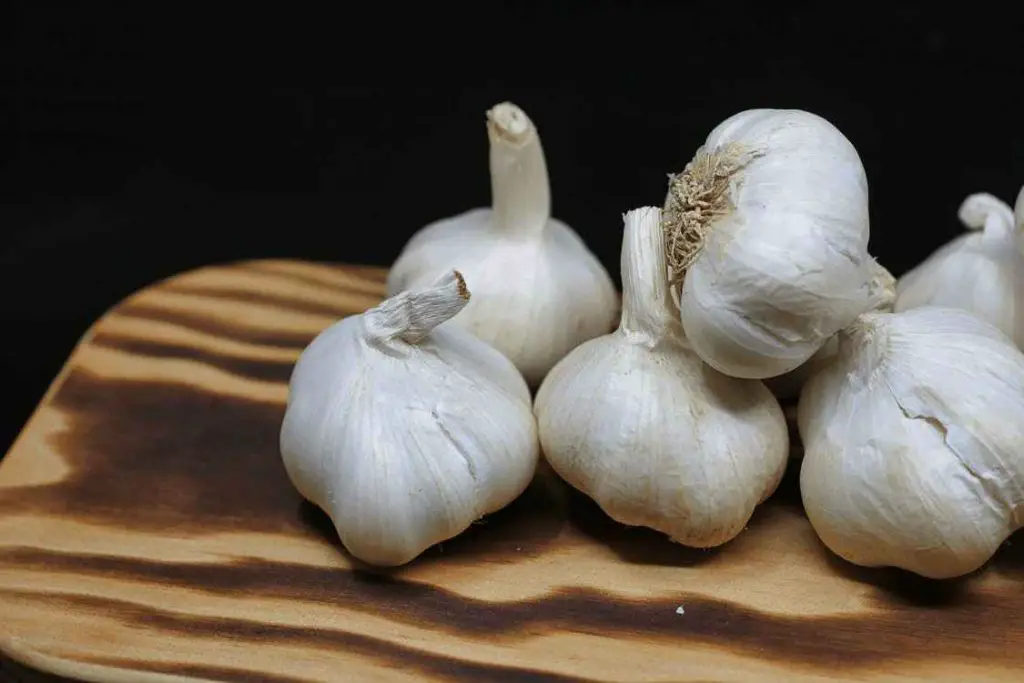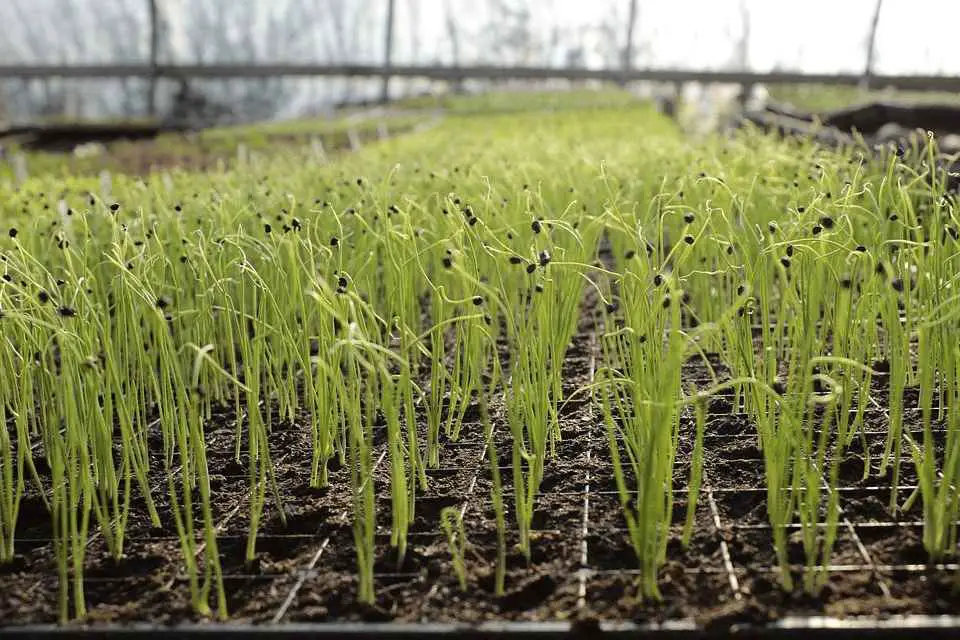Most gardeners recommend planting garlic in mid-October, which works well for most climates. However, when to start growing garlic in different zones? What’s the best planting time to ensure a healthy bumper harvest each time?
Planting time is crucial when growing garlic. It takes a long growing period, over eight months, to reach maturity and give the largest bulbs. Although spring plantings stay in the ground for a shorter period and still gives bulbs for harvest, they’re smaller in size.
Reader Poll: What online courses would interest you?

What Is The Best Time To Start Growing Garlic?
Garlic needs a long growing season with at least six weeks of dormancy during the start of growth, with exposure to cold temperatures to produce the largest bulbs. In colder regions, like and Northern US, garlic is best planted in the fall.
Plant garlic in late summer or autumn, about 6 weeks before the first expected frost. This allows some time for the cloves to develop roots before the onset of winters and then enjoy a dormancy period before resuming growth once the winters are over.
With garlic, planting earlier is always the wiser choice since it gives the plant time to develop a healthy root system before it goes dormant. The fall planting gets a good head start with already developed roots, so the plant can grow quickly as soon as the soil warms up in the coming spring. With a complete eight months in the soil, garlic’s fall plantings will produce the biggest bulbs possible. They’re harvested in midsummers.
Subscribe to our newsletter!
When To Plant Garlic In Different Zones
The ideal planting time for garlic will vary with the zone you live in. Winter arrives at different times for different zones, which is why there cannot be a single ideal planting time for all of these zones.
Go to the USDA website and enter your zip code to learn which zone you live in. Pick the ideal garlic planting time based on your zone. Make sure you order the bulbs or purchase them well in time so you don’t miss the perfect time to plant them.
- Zones 0 – 3 : Plant garlic between early August to late September.
- Zones 3 – 5: Garlic should go in the ground between mid September to mid October.
- Zones 5 – 7: Ideally, garlic should be planted between early to late October.
- Zones 7 – 9: The ideal planting time for garlic starts from late October and lasts into November.
- Zones 9 – 10: Plant between late October to December. Softneck garlic varieties are better suited to these regions since they don’t need as much cold vernalization to develop bulbs as hardneck varieties.
Some Additional Considerations On Selecting Planting Time
- Plant garlic 4 to 6 weeks before the ground freezes over.
- Hardneck garlic needs 4 to 6 weeks of cold temperatures, ideally between 40 to 45 degrees fahrenheit to develop large bulbs. In southern regions, where these temperatures are not a possibility, softneck varieties are the preferred option.
- Planting too early leads to poor bulb development. It may also cause the cloves to rot. Cold temperatures trigger root development in garlic. If you set the cloves in the ground before the cold temperatures set in, no growth will be triggered until the temperatures fall. During this time of no growth, the cloves are susceptible to rot.
Tips For Planting Garlic
Other than the ideal planting time, there are certain other factors that go into creating a successful garlic crop. Here are some tips for planting garlic to ensure bigger and juicier bulbs:
- Wait until planting to break the garlic head and separate the cloves. Keep the papery skin on. Choose the healthiest cloves to plant, free from blemishes or any signs of damage.
- Plant the cloves 2 inches deep, 4 inches apart, with the pointy end facing upwards and the flat end downwards into the ground.
- Plant garlic in well-drained soil, rich in organic matter.
- Mulch the ground with a 4 to 6 inch layer of straw or shredded leaves for proper overwintering.
- Remember to remove the mulch in spring after the threat of frost has passed.
- Don’t add fertilizers at planting time since feeding triggers vigorous growth, susceptible to cold damage when the winter temperatures set in.
- Side dress the plants with a nitrogen-based fertilizer in the spring for healthy foliage growth, which in turn promotes the development of the bulbs.
Will Spring Planting Work?

Most vegetables are planted in spring. Most gardeners start planning the year’s vegetables in spring, so it’s easy to miss garlic’s ideal growing time. So if you skip the fall planting, can you still catch up in spring? How well will garlic do if planted in spring like the other vegetables?
Spring plantings are set about six weeks before the expected date of the last frost. They only stay about 120 to 150 days in the ground before reaching harvest in summers. While you will still harvest mature bulbs, and in a shorter time, they’ll not be as big as those planted before the winters.
Some Tips To Pull Off A Spring Planting
- Choose Softneck Varieties
Softneck garlic varieties generally work better for spring plantings since they can do without a period of cold exposure.
- Plant Early
If you’re planting in spring, plant as early as possible. Garlic is exceptionally cold-hardy and can tolerate temperatures below freezing. Even if cold temperatures are forecasted in the coming days, you can plant them. Planting them towards the end of spring will cause the bulbs to mature quickly, without getting a chance to develop in size.
Plant garlic in spring as soon as the soil is workable, at least 4 to 6 weeks before the last spring frost. In warmer climates, like the southern US, this means that the best time to plant is no later than March. However, in the northern US and Canada, you can plant by early May.
- Vernalization For Hardneck Garlic

It is also possible to grow hardneck garlic in spring, but it will require an extra step to ensure the best growth. It needs a couple of weeks of cold exposure, with temperatures between 27°F and 32°F. Vernalization is the cooling of the seed to accelerate growth and is either achieved through prolonged exposure to winters or an artificial equivalent. Hardneck varieties require about 6 to 12 weeks of vernalization before planting to speed up sprouting and bulbing.
If you’ve missed the winters already or the climate in your region doesn’t get cold enough, placing garlic in the refrigerator before planting is a great option. Store it for at least 2 to 3 weeks, but they’ll benefit from an even longer period in the fridge (2 months ideally).
Is Winter Planting A Good Idea?

You know now that fall planting is the best option since it gives the vernalization during the initial growth stages that garlic requires. If you’ve skipped autumn (usually around October for most regions), should you wait until springtime to plant the cloves, or is winter planting a better option? As a general rule, keep spring planting as your last resort.
Garlic is very tolerant of cold. As long as the soil is workable, you can plant them. So an early December planting will also produce a good crop. Probably not as good as those planted in autumn, but definitely better than spring plantings.
Winter Care
In cold-winter regions, set the cloves 2 to 4 inches below the soil surface to prevent them from cold damage. If garlic is to stay in the soil for the winters, which is the ideal scenario, mulch them with a 6-inch layer of straw or hay before the first frost.
Conclusion
Now that you know when to start growing garlic, remember to plant them in the fall. Give them plenty of time to develop under the soil and give them optimal care throughout the growing season to enjoy big, juicy homegrown bulbs.

